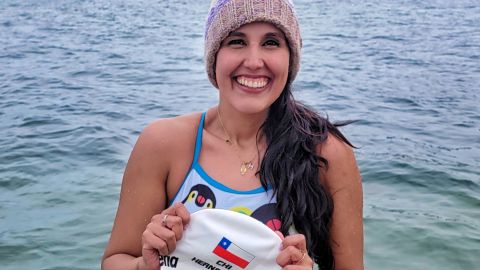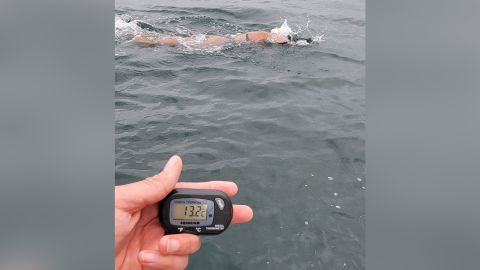CNN —
When Barbara Hernandez was swimming for more than 35 kilometers across the North Channel, the strait between Northern Ireland and Scotland, the freezing waters and powerful currents were the least of her concerns.
That stretch of water is populated by lion’s mane jellyfish, which are among the largest known species of jellyfish in the world with tentacles stretching 30 meters long. Though not deadly to humans, their stings pack a punch and can leave victims in pain for several hours.
During her swim, Hernandez knew it was highly likely that she would come into contact with these jellyfish in the murky waters.
“There were a lot of the jellyfish, I suffered,” Hernandez recalls, maintaining the permanent grin she has when talking about swimming. “In the last part [of the swim] I touched a lot, it was very painful.
“When I swam off Molokai Island in Hawaii, I got stung by the man o’ war, the most dangerous ‘jellyfish’ in the world, and it was painful, but this [the lion’s man] was so much worse. For two days after the swim my skin was still on fire.
“Of course it was scary in the beginning, but in the end it was amazing because it’s the opportunity for us in South America, for me and my team in Chile, it’s the opportunity to prove your limits and that is amazing. I love that.”
After swimming for 12 hours in the freezing water, which also included navigating fog and torrential rain, Hernandez says her feet had turned completely blue.

It takes a very particular kind of mindset for somebody to willfully put themselves through an ordeal like that, but Hernandez’s swim was part of a longtime ambition she has to become the first person to swim parts of all the world’s seven oceans.
Hernandez has completed her swim in the Strait of Gibraltar, the Catalina Channel, the English Channel, the Molokai Channel and the North Channel.
Her next challenge will be the Cook Strait in New Zealand followed by the Tsugaru Strait in Japan, which she aims to complete in 2023.
Hernandez has already broken a number of swimming world records, including the World Open Water Swimming Association (WOWSA) record for being the first person to swim three nautical miles (5.5 km) between the Pacific and Atlantic Oceans and the Guinness World Record for completing the fastest ocean mile swim through the Drake Passage in southern Chile, considered to be among the most dangerous waters in the world.
In 2020, Hernandez’s daring feats of endurance saw her named the WOWSA Woman Of The Year.
Hernandez’s love of swimming began the first time she got into a pool at the age of six.
For 15 years she competed at national and international level in her home country of Chile, but soon after she discovered open water swimming which would quickly become her true passion.
Growing up in the Chilean capital, Santiago, there was no immediate access to the sea, lakes or lagoons, but Hernandez would regularly drive 120 km (74.5 miles) to the coast to get her cold water fix.
Nicknamed the ‘Ice Mermaid,’ Hernandez is also a qualified psychologist, something she says has been crucial to her success in these extreme challenges, with mental preparation for a grueling swim being just as important as the physical.
“I train in my mind in the same fashion as my body,” she explains. “I know the importance of putting a name to your fears, dreams and your passions and working for them. Two years before my [North Channel] swim, I was already preparing for it in my mind.
“Most people are very scared about hypothermia, the cold or the pain and, for me, that is the prize. If I want to be the first South American, the first woman or the first whatever, I need to be prepared for to pay the price and the price is your commitment, your training, your focus on your mind and, of course, your health and your body.”

With hypothermia posing a very real danger every time Hernandez undertakes one of her challenges, the recovery immediately afterward – which includes wrapping up in her specially designed Dryrobe followed by warm showers – is just as important as the preparation.
While her swim across the Drake Passage is the one Hernandez says she is most proud of, she classes her swim across the Chungara Lake in northern Chile to be her most dangerous. At 14,820 feet above sea level, it is among the highest lakes in the world and the lack of oxygen at that altitude can pose even greater risks.
Several of her swims have taken place in waters around glaciers, particularly in the south of Chile, with the hope of raising awareness around the impact of climate change.
“That is my passion,” she says. “Not the medals or the chance to be the first woman from Chile or South America [to break a record].
“That is my opportunity to talk on social media and also with the press and say: ‘Come on, are we are working for the environment or not?’ How can we be useful for another generation to look after our seas or fauna, and also for the jellyfish and the sharks because it’s the home of these animals and these fish?
“Me, a swimmer, I’m just visiting.”
Hernandez has been working with the Chilean navy as she prepares for her next challenge in Antarctica, where she is hoping to raise awareness about the impact of pollution on the environment.
Following that, she will continue on her quest to swim the seven seas with challenges in the Tsugaru Straits in northern Japan and the Cook Strait between the North and South Islands of New Zealand, considered one of the most unpredictable stretches in the world.
But no matter how cold or densely populated with jellyfish the waters are, Hernandez likely will still face these challenges with a grin.

